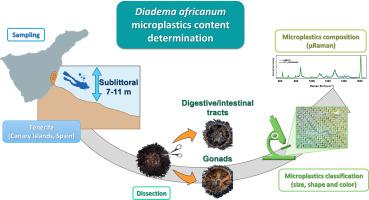Marine Pollution Bulletin ( IF 5.3 ) Pub Date : 2021-11-26 , DOI: 10.1016/j.marpolbul.2021.113174 Marta Sevillano-González 1 , Javier González-Sálamo 2 , Francisco J Díaz-Peña 3 , Cintia Hernández-Sánchez 4 , Sergio Catalán Torralbo 5 , Airán Ródenas Seguí 6 , Javier Hernández-Borges 2

|
Sea urchins are highly abundant in the marine ecosystem where they graze limiting algal biomass and also serving as food for other predators. In this work, the presence of microplastics in the digestive tracts and gonads of 33 Diadema africanum sea urchins collected at two sampling points in Tenerife (Canary Islands, Spain) was studied. After separation and digestion of the digestive tracts and the gonads, the visualization of the filtrates under the stereomicroscope revealed the presence of 320 items which were microfibers (97.5%), fragments (1.9%) and films (0.6%), mainly blue (43.3 and 47.0% in the two sampling points, Tajao and El Porís, respectively) and translucent white (32.5 and 39.5%, respectively). Statistical analysis revealed that there were no significative differences in the contents of gonads and digestive tracts between both sampling locations. Regarding microfibers lengths, significative differences were only observed between the two sampling points, not between tissues. μRaman analysis showed that they were mainly cellulosic (46.0%), polypropylene (24.3%) and polyethylene terephthalate (24.3%). This study confirms for the first time the presence of microplastics in sea urchins from the Macaronesian region and also from Spain.
中文翻译:

特内里费岛(西班牙加那利群岛)Diadema Africanum 海胆中微塑料含量的评估
海胆在海洋生态系统中非常丰富,它们在那里吃草,限制了藻类的生物量,也作为其他捕食者的食物。在这项工作中,33 Diadema Africanum的消化道和性腺中存在微塑料研究了在特内里费岛(西班牙加那利群岛)的两个采样点收集的海胆。消化道和性腺分离消化后,体视显微镜下滤液可见320个,分别为微纤维(97.5%)、碎片(1.9%)和薄膜(0.6%),主要是蓝色(43.3和 47.0% 在两个采样点,分别是 Tajao 和 El Porís)和半透明白色(分别为 32.5 和 39.5%)。统计分析表明,两个采样点的性腺和消化道含量没有显着差异。关于微纤维长度,仅在两个采样点之间观察到显着差异,而不是在组织之间。μRaman 分析表明它们主要是纤维素 (46.0%)、聚丙烯 (24. 3%)和聚对苯二甲酸乙二醇酯(24.3%)。这项研究首次证实了来自马卡罗尼西亚地区和西班牙的海胆中存在微塑料。











































 京公网安备 11010802027423号
京公网安备 11010802027423号